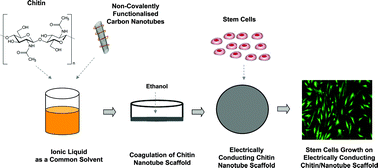Ionic liquids-based processing of electrically conducting chitin nanocomposite scaffolds for stem cell growth
Abstract
In the present study, we have successfully combined the biocompatible properties of

Maintenance work is planned for Wednesday 1st May 2024 from 9:00am to 11:00am (BST).
During this time, the performance of our website may be affected - searches may run slowly and some pages may be temporarily unavailable. If this happens, please try refreshing your web browser or try waiting two to three minutes before trying again.
We apologise for any inconvenience this might cause and thank you for your patience.
* Corresponding authors
a
School of Cellular & Molecular Medicine, University of Bristol, Bristol BS8 1TD, UK
E-mail:
w.z.kafienah@bristol.ac.uk
Fax: +44 (0)117 33 12091
Tel: +44 (0)117 33 12096
b Department of Materials Science and Metallurgy, University of Cambridge, Cambridge CB2 3QZ, UK
c Centre for Organized Matter Chemistry, School of Chemistry, University of Bristol, Bristol BS8 1TS, UK
d Sustainable Polymers Group, Materials Science and Engineering Division, National Institute of Standards and Technology, Gaithersburg, MD 20899, USA
e Department of Chemistry, United States Naval Academy, Annapolis, MD 21402, USA
f
Advanced Composites Centre for Innovation and Science (ACCIS), Aerospace Engineering, University of Bristol, Bristol BS8 1TR, UK
E-mail:
Sameer.Rahatekar@bristol.ac.uk
Fax: +44 (0)117 33 15330
Tel: +44 (0)117 33 15330
In the present study, we have successfully combined the biocompatible properties of

 Please wait while we load your content...
Something went wrong. Try again?
Please wait while we load your content...
Something went wrong. Try again?
N. Singh, K. K. K. Koziol, J. Chen, A. J. Patil, J. W. Gilman, P. C. Trulove, W. Kafienah and S. S. Rahatekar, Green Chem., 2013, 15, 1192 DOI: 10.1039/C3GC37087A
To request permission to reproduce material from this article, please go to the Copyright Clearance Center request page.
If you are an author contributing to an RSC publication, you do not need to request permission provided correct acknowledgement is given.
If you are the author of this article, you do not need to request permission to reproduce figures and diagrams provided correct acknowledgement is given. If you want to reproduce the whole article in a third-party publication (excluding your thesis/dissertation for which permission is not required) please go to the Copyright Clearance Center request page.
Read more about how to correctly acknowledge RSC content.
 Fetching data from CrossRef.
Fetching data from CrossRef.
This may take some time to load.
Loading related content
